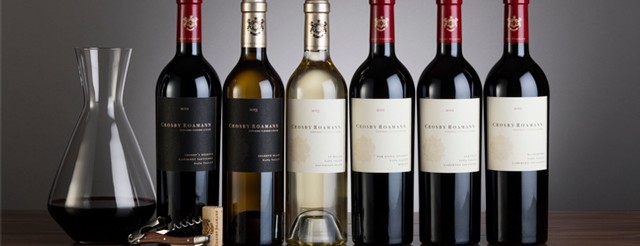News, reviews, and updates from the estate.
Cooking with Crosby Roamann: Sourdough boule with Cranberries and Walnuts
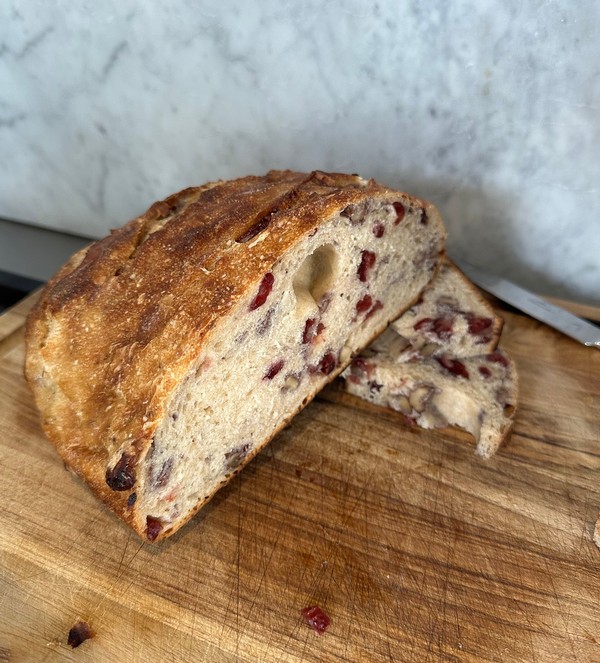
To change things up this week Juliana suggested we add dried cranberries and walnuts to our weekly sourdough. We added a half cup of dried cranberries and a half-cup of chopped walnuts and folded them into the dough as we performed our first three stretchings of the dough. We then let it rest overnight to rise. In the morning, we transferred the risen dough to a clean bowl, chilled it for an hour in the fridge (while the over heated up) and then baked it using our standard recipe from FeastAtHome.com for 15 minutes at 500F covered, and another 15 minutes at 450F uncovered. I found that I preferred this bread slightly toasted and slathered with butter, but then again, I always do!
Cooking with Crosby Roamann: Spring Quiche with Cauliflower, Ham & Gruyere
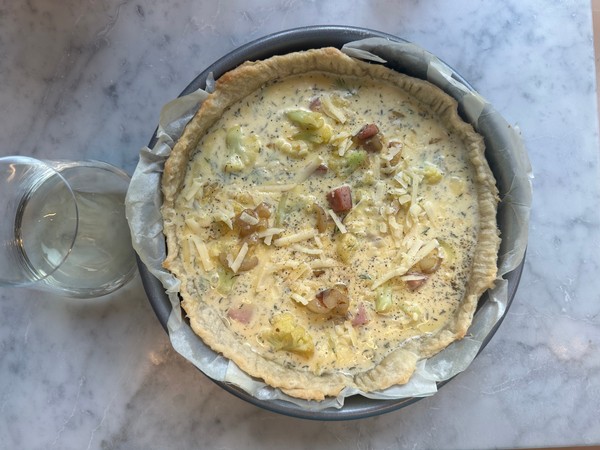
Quiche starts to make an appearance in our house around this time of year, maybe because it makes such a wonderful Sunday Brunch. We like to include things from our winter garden -- chives, scallions, green onions, dill, and cauliflower -- and pair it with a well-chilled bottle of our Sauvignon Blanc -- as we like to serve it with winter lettuces fresh from the garden.
Our basic pie dough crust comes from Smitten Kitchen (you can find it here). We follow the instructions as closely as we can and always love the results -- a slightly sweet pie dough that matches well with anything from a savory quiche to a Maple Cream Pie.
For our spring quiche filling we use 5 eggs, 1 cup of cream, and 2 cups of grated gruyere cheese, plus two shallots, two cups of cauliflower florets, and one and a half cups of cubed ham steak, sauteed in three tablespoons of butter until gently browned all over.
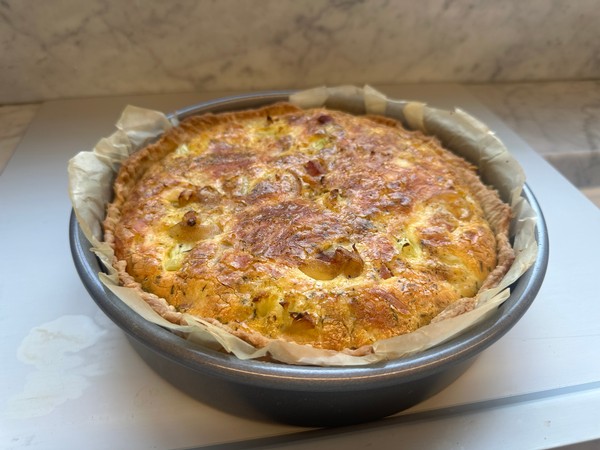
Ingredients
- Smitten Kitchen Basic Pie Dough
- 5 eggs
- 1 cup of cream
- 2 cups of grated gruyere cheese
- 2 shallots, sliced very thinly
- 2 cups of cauliflower florets, about 1" each
- 1.5 cups of cubed ham steak, about 1/2" cubes
- 3 tablespoons of butter
- 3 tablespoons of olive oil
- Salt and pepper to taste
- 1 tablespoon fresh dill, minced
- 1 tablespoon diced chives, optional
Directions
- Prepare the pie dough and par-bake it, set it aside to cool.
- Reduce the over temperature to 300F
- In a large sauce pan, sautee the shallots, cauliflower, and ham steak in the butter and olive oil, until they are lightly browned, about 10 minutes, stirring along the way. Then set these aside to cool.
- Meanwhile, combine the eggs and cream in a medium bowl and whisk to combine. Add the cheese.
- When the cauliflower mix has cooled slightly, add this to the bowl of eggs and cream. Add the fresh dill, and stir to combine. Add the chives if desired.
- Set the pie shell in a rimmed baking sheet (for ease of transport).
- Fill the pie shell to the edge with your quiche filling, and transfer it to the middle shelf in the oven.
- Bake for 50 minutes at 300F, or until a knife inserted in the middle comes out clean.
Enjoy with a nicely chilled glass of our Sauvignon Blanc.
Cooking with Crosby Roamann: Lamb Stew with White Beans paired with Estate Red wine
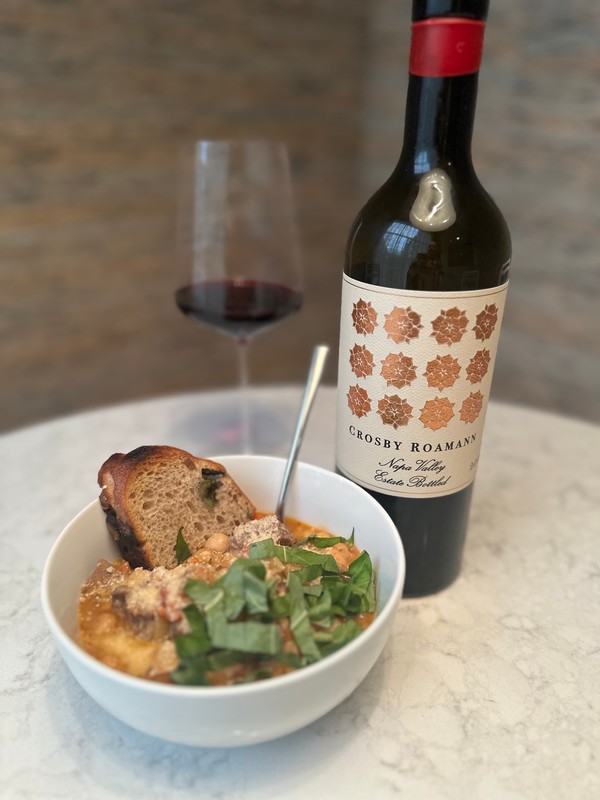
INGREDIENTS
- 4 clove garlic, sliced very thinly
- 2 carrots, chopped into ½” pieces
- 1 celery, chopped into ¼” pieces
- 1 onion, chopped ¼” pieces
- 1” peeled fresh ginger, chopped (optional) diced
- 1 box chicken stock
- 1 can diced tomatoes
- 2 dashes Tobasco
- 1 cup dry white wine
- 2 lb. boneless lamb shoulder
- 1 lb. mild Italian sausage links
- 1 lb. dry Northern white beans, soaked overnight
- Kosher salt and pepper
- Chopped flat-leaf parsley or basil and crusty French bread, for serving
DIRECTIONS
- Hydrate beans overnight, rinse and clean
- Preheat the oven to 350F.
- In a large saute pan, sauté carrots, celery, onion, garlic, and ginger, just lightly ~ 5 minutes
- Add the wine and reduce to simmer to burn-off alcohol ~ 5 minutes
- Combine the sautéed garlic, carrots, celery, onion, and ginger with the white beans in a 5- to 6-qt Dutch oven, and cover with chicken stock (top with water if necessary).
- Return the saute pan to the heat and add another 2 tablespoon of olive oil. Season the lamb with salt and pepper, and working in batches, slowly brown the meat before adding it to the dutch oven.
- When you have added all the lamb to the dutch oven, and tucked the meat in nicely with the beans, cover the Dutch oven and put it in the oven to cook on 350F for the first hour.
- Have a glass of wine!
- While the lamb is cooking for the first hour, sauté the sausage links briefly next, then let them cool. Slice them into 1 inch pieces on a bias, and at the end of the first hour of cooking lamb, then add the sausage pieces to the dutch oven.
- Add the tomatoes and gently mix everything together.
- Cook 1-2 more hours on low to combine. The lamb should be soft and easy to pull apart with a fork.
- Sprinkle with the parsley or julienned basil, and serve with our sourdough boule.
Cooking with Crosby Roamann: Sourdough
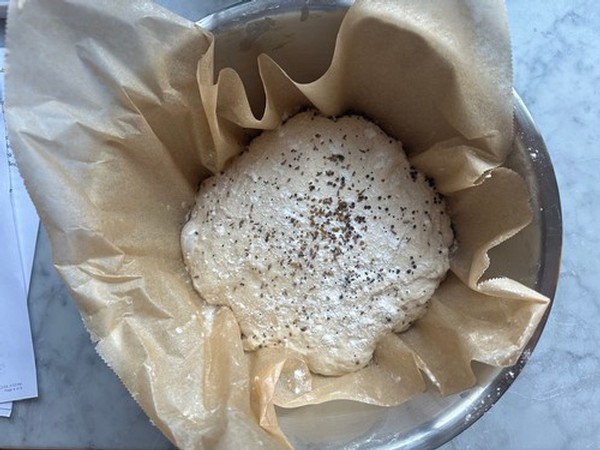
Every year, as our grapes slowly ripen, we take fruit samples from the vineyard. Sampling begins generally in mid-August for our Sauvignon Blanc, and continue through our last harvest of the vintage, typically mid-October. The practice is simple, but time-consuming. A 100 to 200-berry sample is collected in a sandwich bag from each block being tested by gently harvesting one berry per cluster from roughly every-other vine until we've reached our sample collection target. We then crush the berries in the sample and chill them to 68F. Then we check the sugar content (i.e. Brix) in a refractometer. Sometimes, the juice sample is sent out for professional chemistry including acidity and pH, among other things.
If the weather is just right, the grapes will be the right temperate for testing with our refractometer right there in the field, and then often the jucie samples get left in the car ... and forgotten, and a day or two later, they will begin to ferment.
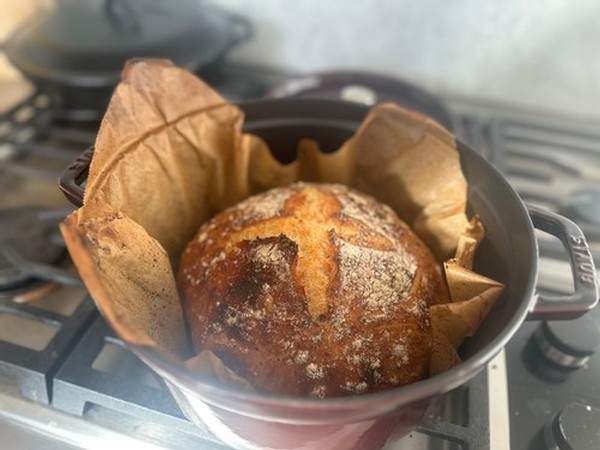
This year, I decided to put some of these spontaneous grape sample fermentations to good use. Following a recipe from Sylvia Fountain at FeastingAtHome.com, I collected the juice from our berry samples and made a sourdough bread starter with it. The results have been incredible.
I followed the traditional sourdough starter recipe -- 1/2 cup wholewheat flour, and 1 cup water -- but to this I added 1/4 cup of fermenting grape juice. I made this addition two or three times over the course of the first week as the starter got going. When we made our first boule, at the end of that first week getting the starter going, I added an additional 1/4 cup of fermenting grape juice.
Cooking with Crosby Roamann: Sweet "Hungarian" Paprika
It was one of those special days of the year when, over the weekend, Juliana and I harvested a grocery bag's worth of bright red Hungarian-bred sweet red peppers and brought them home to process. The process is relatively easy. We wash and dry the peppers, and then cut them lengthwise by hand and remove most of the ribs and seeds. Next we lay them out on a large rimmed baking sheet lined with parchment pepper. Then we dry them in the oven at the lowest temperature we can get, which in our oven is only 200F (a lower temperature of 140 would be ideal, but it would take longer ... much, much, much longer). The drying process at 200F takes about 5-6 hours, after which we let the dried peppers cool over night. In the morning, we crush them by hand, and process them into a fine powder in our spice grinder (from Cuisinart). Lastly, storage! We keep our sweet "Hungarian" paprika in an air-tight container in the fridge, in which condition it will last all year long, and often longer.
Interested in learning more? Let us know! Visit the "Contact us" page and give us a shout.
Next recipe coming up -- Chicken Paprikas.
Cooking with Crosby Roamann: Feta Cheese Toast
Feta Cheese Toast
- Tablespoon butter
- 4-6 slices good bread, about ½ inch thick, toasted
- 4-6 slices good prosciutto
- Garlic powder to taste
- Maldon sea salt to taste
- Cracked fresh pepper to taste
- Ground cumin pinch to taste
- Dry oregano or fresh garnish to taste
- 2 tablespoons Olio Nuovo or good olive oil
- Leftover crumbled Feta cheese, about 4 oz.
Prep
- Place 1 tablespoon butter on a large plate and microwave on high for 40 seconds
- Meanwhile, toast 4-6 pieces of good bread, like a sourdough boule.
- Place the toast in the butter and sprinkle a pinch of garlic salt on them, then flip them over, and place a piece of prosciutto on each slice of toast, tucking the edges of the prosciutto under the bread.
- Layer on your crumbled Feta cheese generously.
- Sprinkle the tops with Maldon Sea Salt, cracked fresh pepper, a touch of ground cumin (just a little pinch!) and a touch of dry (we used fresh) oregano (use a little more if you want a garnish).
- Then drizzle your best olive oil (we used our Olio Nuovo from 2023) generously over the tops of the toast – about 2 tablespoons worth.
Et voila! Feta Cheese Toast. We paired this with our Tuna Puttanesca, pictured below, and a bottle of good old Merlot. What I love about these little dishes is that I had everything I needed to make them at home. They are so simple and delicious and comforting and we didn't even have to go grocery shopping for anything! Did you know, "Puttanesca translates as “in the style of the whore.” The name derives from the Italian word puttana which means whore. Puttana in turn arises from the Latin word putida which means stinking." But boy, what a dish! xo
Cooking with Crosby Roamann: West Coast Style Gefilte Fish
There is one common staple in our house over Passover, and that is gefilte fish. Traditionally, I make enough for everyone, and then am the only one to eat it. But that’s ok. These things take time. I didn’t love, or even like, or even try, gefilte fish when I was a kid either.
When we lived in NY, it was easy enough to purchase really good gefilte from one of our local grocers, but here in wine country – no such luck. So, I took to making it myself from scratch when we moved here. The first versions weren’t very good -- it turned out to be nearly impossible to find the traditional fish in the right quantities in California. So, I adapted.
Our recipe is a “west coast” adaptation of the basic gefilte recipe from the great book The Gefilte Manifesto. All of the ingredients are easy to find at almost any good fishmonger and grocer this time of year.
Enjoy, and happy pesach.
West Coast Style Gefilte Fish
For the fish stock
- 1 lb spine and head, Halibut bones
- 4 qts water
- 1 Tbsp kosher salt
- 2 small onions
- 4 medium whole carrots
- 3 Tbsp sugar
Add all ingredients and simmer for 45 minutes. Strain the stock and remove the carrots, cutting them into 1” pieces and set ting them aside. Discard the remaining solids and return the stock to the stove top.
For the Gefilte Quenelles
- 1 lb California or Canadian Halibut fillet, skinned
- 1 lb California Sturgeon fillet, skinned
- 2 small onions
- 2 small eggs
- 2 Tbsp vegetable oil
- 2 Tbsp chopped fresh dill (plus more fresh sprigs for garnish set aside)
- 2 Tbsp sugar
- 1 Tbsp kosher salt
- ¼ tspn fresh ground black pepper
- ¼ cup Matzah meal
- Horseradish, fresh, for serving.
Prep
- Grind the onions, then the fish with it, and then all the remaining ingredients in a food processor. Remove the Gefilte mix to a bowl, cover and refrigerate for 30 minutes.
- Begin to reheat the stock on low. It should be warm, not hot/cold.
- Wet your hands, and roll out large egg-shaped quenelles, just smaller than a tennis ball. Place them gently in the stock using a slotted spoon, one by one.
- You should have about 12-14 quenelles, depending on size.
- Cover and boil the stock and quenelles on medium high for 30 minutes. Then let cool slightly.
- Line a serving dish with carrots and quenelles, then cover with stock, and garnish with a few fresh sprigs of dill, then wrap tightly with plastic and refrigerate. The quenelles are served cool, best the next day and for 3 days after.
- Serve with fresh horseradish and matzah for Passover.
Prepared Horseradish garnish recipe:
- 1 (8 to 10-inch long) piece horseradish root (4 to 5 ounces)
- 2 tablespoons water, more as needed
- 1 tablespoon white vinegar, more as needed
- Pinch salt
Peel and chop your horseradish root into half inch cubes, then pulse in a sturdy food processor with the other ingredients. Store in the refrigerator for up to 3 weeks (or as long as it takes to finish all the gefilte fish the rest of your family refused to eat.)
Cooking with Crosby Roamann: Seared Herb-Crusted NY Strip Steak with BA.1 Steak Sauce
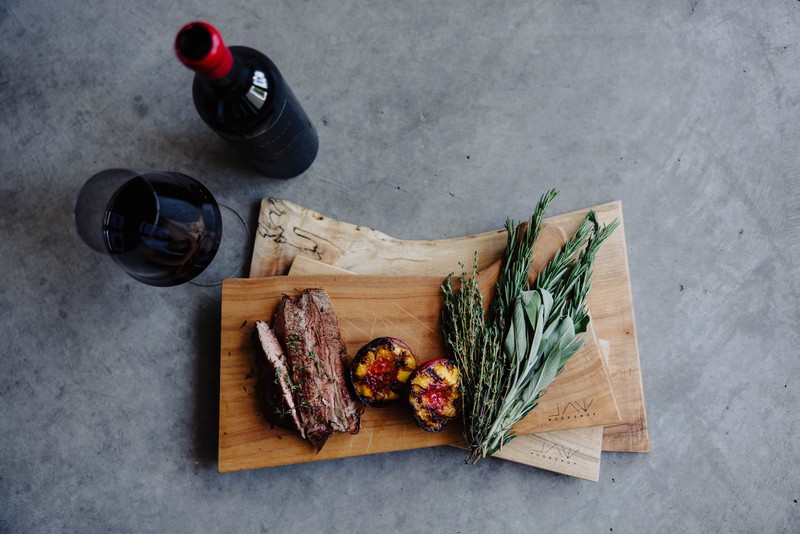
For our herb-crusted NY Strip Steak, we choose prime cuts at least 1-inch think, and apply a rub of 1 tablespoon each dried thyme, rosemary, oregano, and Kosher Salt. We let these sit for the day in the fridge, and then for an hour at room temperature before cooking. We prefer cast iron skillets for searing steaks at home, with one tablespoon of butter and a tablespoon of good olive oil, which we let begin to smoke in the skillet before we add the steaks. We fry these at the highest temperature we can for 3-4 minutes per side, and then finish them in the oven, covered for 2-4 minutes, until an instant read thermomemter registers 145F interior temp. We then let the steaks rest on a wood cutting board for 5 minutes before serving.
Pair this with our 2020 Crosby's Reserve Cabernet Sauvignon, available here.
- 2 Tbsp. balsamic vinegar
- 2 Tbsp. Worcestershire sauce
- 2 Tbsp. ketchup
- 1 Tbsp. extra-virgin olive oil
- 1 Tbsp. vinegar-based hot sauce (such as Frank’s or Crystal)
- 1 tsp. Dijon mustard
- 1 tsp. honey
- Kosher salt
Combine ingredients in a small bowl and mix well. BA says, "sauce can be made 2 months ahead. Store airtight at room temperature," but we store ours in the fridge.
Cooking with Crosby Roamann: Roast Chicken with Olives
It’s probably our favorite meal in the world … so there, I said it. No trip to Paris is complete for our family if we don’t visit Restaurant Allard, Alain Ducasse’s staple bistro near the heart of Saint-Germain-de-Pres. We’ve spent years trying to recreate the dishes we found there, and while it will never be exactly the same as sitting in the back of their small Parisian dining room and enjoying truly fine French bistro, it comes darn close. Enjoy this Roast Chicken (or Duck) with olives with our Thanksgiving selections or a magnum of Merlot. (The bird pictured here is with some late harvest zucchini form our garden while the olives finished cooking in their gravy).
- 2 tablespoons rendered chicken fat (or substitute 1 tablespoon oil and 1 tablespoon butter).
- 2 pounds chicken wings or backs, cut up.
- 1 chicken or duck (about 4 pounds, well-rinsed, patted dry, and trussed with neck and gizzard reserved.)
- 3 onions minced
- 1 1/2 tablespoons superfine flour
- 2 cups dry white wine
- 2 quarts chicken stock
- 1 bouquet garni: 12 parsley stems, 8 peppercorns, 1/4 teaspoon thyme, 1/4 teaspoon fennel seed and 1 bay leaf tied in a double thickness of cheesecloth.
- 1/3 cup tomato paste
- 8 ounces, brine-cured, pitted green olives
- 2 tablespoons unsalted butter, softened
In a large, nonreactive stockpot or stovetop casserole, melt the chicken fat over medium heat. Add the chicken pieces and reserved duck neck and gizzard. Cook, stirring over medium-high heat, until golden, about 8 minutes. Add the onions and cook until softened, about 5 minutes. Sprinkle on the flour and cook, stirring, for 1 minute. Stir in the wine, stock, bouquet garni, and tomato paste. Simmer, uncovered, over low heat for 2 hours, stirring occasionally. Strain the sauce through a fine mesh sieve into a nonreactive saucepan. Discard the solids.
Bring 1 quart of water to a boil in a medium saucepan. Add olives and boil over high heat for 2 minutes. Drain and rinse well under cold water. Taste an olive. If they are still very salty, repeat the blanching. Add the olives to the strained sauce. Set over low heat and simmer, uncovered, until the sauce is just thick enough to coat a spoon, about one to one-and-a-half hours.
Preheat the oven to 425 degrees.
Pierce the chicken or duck skin all over with a knife and rub the skin with the butter. Place the bird, breast side down, on a rack in a roasting pan and roast for 30 minutes. Reduce the oven temperature to 350 degrees. Turn the chicken or duck breast side up. Continue to roast the bird until the juices run clear when you pierce the thigh with a skewer, about one hour more. If you find that the breast is brown before the bird is cooked through, shield the breast by covering it loosely with aluminum foil.
To serve, carve the bird. Arrange the meat on a large serving platter and surround it with the green olives and sauce. Yield: 4 servings.
Cooking with Crosby Roamann: Juliana's Purple Plum Torte
If you have ever been invited over to our house in late August or early September, or if you've invited me to your home for a meal during this same time frame and asked me to bring dessert, you have probably eaten this cake! This is my all-time favorite recipe from Deb Perelman of Smitten Kitchen fame. I love Italian plums and this cake could not be easier or more delicious. What truly sets this apart is the last minute step of fresh squeezed lemon on top of the sliced plums, followed by a sprinkling of cinnamon and sugar before it goes into the oven. When Italian plums are in season, do yourself a favor and make this for yourself, and maybe share with people you truly care about, and only them.

